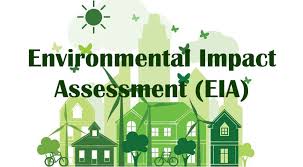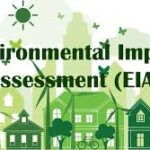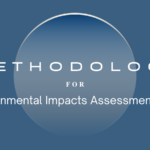1) EIA is defined as
a) process of identifying, predicting, and evaluating the likely impacts of a proposed project or development to define mitigation actions to reduce negative impacts and to provide positive contributions to the natural environment and well-being
b) report written by government representatives on the planned development impacts of environment, socio-economic issues and culture
c) project life-cycle assessment
d) none of above
Answer: a
2) What is essential in an EIA?
a) that it allows decision makers to assess a project’s impacts in all its phases
b) that it allows the public and other stakeholders to present their views and inputs on the planned development
c) that it contributes to and improve the project design, so that environmental as well as socioeconomic measures are core parts of it
d) All of the above
Answer: d
3) What is the purpose of the “screening” step of EIA?
a) To assess the quality of the project design
b) To facilitate informed decision making by providing clear, well-structured, factual analysis of the effects and consequences of proposed actions
c) To determine whether a full EIA needed
d) b and c both
Answer: d
4) EIA is study of probable change in socio economic and ________ characteristics of environment due to proposed action.
a) biophysical
b) geological
c) hydrological
d) Potential
Answer: a
5) What is included in an Impact assessment?
a) a detailed assessment of the planned project and selected alternatives compared to the baseline conditions
b) Qualitative descriptions measuring high, medium and low impacts
c) Quantitative descriptions such as indicating the cubic metres of water withdrawn, sewage produced, and pollutants released
d) All of the above.
Answer: d
6) What is a contingency plan?
a) A set of guidelines ensuring that the development project will remain within its boundaries.
b) A plan of actions to prevent an emergency and to be taken when emergencies occur.
c) A plan describing the measures that will be taken to contain or treat any waste produced by the
development project.
d) None of the above
Answer: b
7) EIA is ______and ___________ environmental impacts.
a) beneficial and adverse
b) social and benefit
c) adverse and economical
d) None of above
Answer: a
8) ___________ is evident that order to identify, assess and predict the environmental impacts.
a)Environmental attributes
b) Environmental impact
c) Complex system
d) Variable parameter
Answer: a
9) Prediction of impact is ________.
a) qualitative
b) quantitative
c) economic
d)beneficial
Answer: a
10) EIA is a _______ which helps to evaluate environmental impact of proposed developmental projects
or programs.
a) quantitative
b) tool
c) subjective
d) clearance
Answer: b
11) EIA was introduced in India in ____ .
a) 1978
b) 1976
c) 1879
d) 1789
Answer: a
12) Screening criteria based on ______ .
a)type and location of development
b) difficult and control attribute
c) type and difficult to development
d) partial development
Answer: a
13) Scoping is procedure of _________environmental issues.
a) identifying
b) impact
c) physical impact
d) attributes
Answer: a
14) EIA is including mechanisms for monitoring, __________ and evaluation.
a) specification
b) auditing
c) reporting
d) concluding
Answer: b
15) EIA is _______ step activity.
a) three
b) four
c) two
d) five
Answer: b
16) Prediction include determination of __________ and magnitude of impact.
a) nature
b) action
c) predict
d) extend
Answer: a
17) Prediction is ________ data and technical knowledge.
a) scientific
b) evaluate
c) error
d) operational
Answer: a
18) EIA is ________ tool for decision making process.
a) management
b) social
c) essential
d) systemating
19) __________ required to measure the variables.
a) Skills
b) Value
c) Data source
Answer: a
20) EIA is ________ report.
a) applicant
b) logical
c) legal
d) documental
Answer: a
21) Lead agencies decided whether ________ is required or not.
a) EIS
b) EIA
c) MOEF
d) SPCB
Answer: b
22) Lead agency decision on whether issue permit __________ or the project.
a) rejected
b) decided
c) approved
d) negotiated
Answer: c
23) EIA is ________ study to delineate between beneficial and detrimental impacts.
a) micro
b) action
c) proposed
d) macro
Answer: d
24) Which are environmental attributes?
a) Detailed attributes
b) Review level attributes
c) Economic attributes
d) a and b both
Answer: d
25) EIA is__________ consuming process.
a) Time
b) Preventive
c) Control
d) Short term
Answer: a
26) EIA is intristic link between __________ and economic growth.
a) ecological
b) polluted
b) beneficial
c) environment
Answer: d
27) Identification may confirm and _.
a) existing
b) new one added
c) stages complete
d) invite
Answer: b
28) The baseline studies in EIA pertain to __.
a) Collection of demographic data only
b) prediction of significant residual environmental impact
c) existing environmental settling of proposed development area
d)selection of best project option available
Answer:c
29) Which one of the following steps is not included in the scoping process?
a) baseline description and potential additional data collection needs
b) description of environmental impacts and creation of contingency plan
c) defining set of criteria to assess the projects
d) settling of expert team that will conduct EIA
Answer:b
30) which capacity based on developmental planning process?
a) regional carrying capacity
b) economic development
c) quality of life
d) resources
Answer: a
31) EIA is way of evaluating and controlling______
a) different development activities
b) beneficial and adverse impact
c) quality of human, environment
d) proposed action or project
Answer: c
32) EIA is report to relevant regulatory authority. a)
applicant
b) polluter
c) applicable
d)all of the above
Answer: a
33) _______ must pay principle is applicable.
a) MOEF
b) GPCB
c) polluter
d) applicable
Answer: c
34) EIA may define formal process used to predict environmental consequences of _____
a) identify project
b) any development projects
c) reduced cost
d) impact of laws
Answer: b
35) EIA is supporting the goals of environmental protection and _______.
a) sustainable development
b) economic growth
c) involvement of public
d) proposed activities
Answer: a
36) EIA is provided for ________ of public, government agencies to review proposed activities.
a) beneficial
b) mitigation
c) involvement
d) adverse
Answer: c
37) is a way of mapping environmental consequences of significant aspect of project.
a) Impact prediction
b) social impact
c) adverse effect
d) economic
Answer: a
38) Scale and severity of impact is determined by whether it is .
a) development
b) reversible
c) adverse
d) reversible or irreversible
Answer: d
39) EIA is necessary because …………
a) development is bad for the environment
b) there is growing interest in sustainability
c) environmental impacts of developments are of public interest
d) none of the above
Answer: c
40) Which of the following statements are false?
a) land use planning systems do the same thing as EIA
b) EIA is costly and time consuming
c) EIA is intended to be a rational and comprehensive assessment
d) EIA is a process
Answer: b
41) Where undertaken, EIA should be used to help determine whether consent is given for
development?
a) never
b) hardly ever
c) often
d) always
Answer: d
42) The primary reason for Environmental Impact Assessment is to
a) mitigate existing environmental impacts of development
b) predict the size of impacts of developments
c) describe proposed developments
d) identify the environmental consequences of development in advance
Answer: d
43) Environmental impact assessment is ________ specification.
a) site
b) time consuming
c) quantification
d) energy resource
Answer: a
44) Which is EIA methodology?
a) assessment
b) mitigation
c) adverse
d) land use
Answer: b
45) The EIA procedure identifies the possible positive and negative impacts to the environment
resulting from a proposed project. These impacts are identified over both ______ and
_____ time frame.
a) short term and long term
b) adverse and time consuming
c) beneficial and short
d) adhoc and matrix
Answer: a
46) Who will be decided EIA required or not?
a) public
b) consumer
c) lead agency
d) EIAS
Answer: c
47) what is EIAS?
a) environmental impact assessment statement
b) environmental Indian association statement
c) environmental international assess state
d) none of the above
Answer: a
48) EIA is evaluating and simulator quality of _____.
a) economic
b) human and environment
c) action
d) proposed
Answer: b
49) Screening is whether project required ________ as per statutory notification.
a) environmental clearance
b) environmental impact assessment
c) Seia
d) EIAS
Answer: a
50) Mitigation measures may be ________ public awareness programme.
a) lead agency
b) correction
c) preventive
d) aspect
Answer: c







1 thought on “Objective Type Questions (Environmental Impact Assessment)”